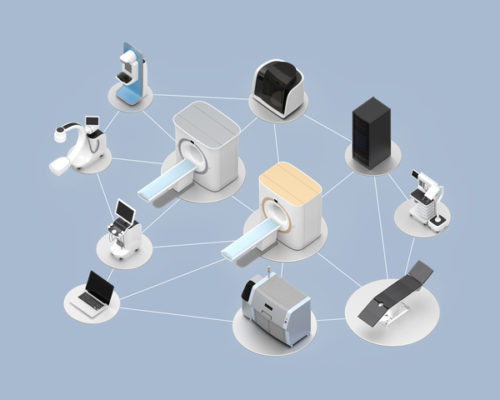In a recent Verizon report on the adoption of IoT in various industries between 2016 and 2017, healthcare came in last with only an 11% increase. This is compared to manufacturing as the far-and-away leader at 84%, followed by utilities/energy (41%) and transportation/distribution (40%).

Why is there such a low IoT adoption rate in healthcare? HealthcareITNews author Bill Siwicki believes that it’s a combination of 3 main factors: cost, security, and data integration.
Of the 3, I find one in particular requires a unique perspective for healthcare: data integration.
What about cost and security you ask?
They are no doubt important, however, their solutions are further along in maturity.
Cost becomes a sticking point when there is no business justification. In evaluating IoT initiatives, there needs to be an examination of the potential benefit compared to the cost. For healthcare, an IoT use case can increase revenue or reduce/eliminate other costs. It does not have to be a long drawn out evaluation process. Take a look at Bill Schmarzo’s blog [The #1 IOT Challenge: Use Case Identification, Validation and Prioritization] on prioritizing IoT use cases as a framework for quickly assessing the business value of IoT.
Once there is business justification, you also need to consider security. The key isn’t to look at security as an issue in which to solve because you’re introducing a new and innovative IoT solution. Your environment is already loaded with vulnerable connected devices for bad guys to exploit:

From this perspective, security is an existing and critical issue that needs to be addressed with or without your new IoT initiative.
Security is a topic to its own, and while I am not deep diving into it here, there is one technique I’m seeing as an emerging solution. It consists of using virtual networks and micro-segmentation to keep potentially risky devices from having open access to your network. Check out the whitepaper, “Micro-Segmentation Builds Security Into Your Data Center’s DNA“, for more information.
So many devices, so much data
Assuming the IoT use case has business justification and security is being addressed, your IoT initiative still has to be integrated – the biggest hurdle for healthcare providers in my view.
The challenge is the devices on the market are all proprietary and the data they crank out (in mass quantity) doesn’t always align to the core data sets in the electronic medical record and other healthcare applications. Now you have a problem that needs some new thinking.
Why?
For years we have been trained in IT to take data, normalize it and neatly file it into data warehouses where we can access it later. This approach has shown to have 2 problems: it takes too long and doesn’t adapt well to changes like the introduction of new data sources. Your IoT business case doesn’t allow for a 9-month cycle of data modelling to come up with an elegant schema that will be broken as soon as you introduce another device.
Big data to the rescue
This would be a serious obstacle, however, the good news is it’s being addressed in the big data arena. Big data has been defined as an environment comprised of volume, variety and velocity of data inputs. This is exactly what we are dealing with when adopting IoT solutions.
With IoT, the data lake approach shifts:

The key concept is that a data lake is well-suited for taking data from any source, including IoT devices, that produces data in various formats (e.g., HL7, SQL, proprietary, etc.). The data is then resolved at run-time taking advantage of modern technologies like Hadoop. The benefit to that is the ability to be both flexible and responsive in adding new sources and devices.The article, “The Data Lake: What It Is, What It’s For, Where It’s Going” explains the concept in more detail and you can also find for more information on data lakes here.
When you look at it this way, the issue of IoT data integration for healthcare is essentially the same as the data aggregation being addressed by data lakes. Case in point is a solution provided by one of our partners, Medical Informatics Corporation (MIC). Using a data lake approach, their solution takes all the data streams from all the connected devices in an ICU setting and creates a single view with predictive analytics that help clinicians spot trends early.

Looking ahead
So, what will the IoT uptake in healthcare be over the next 12 months?
Time will tell but I’m expecting it to be a more significant jump than the 11% from last year. There are IoT uses that are simply too profitable to ignore and my bet is on IoT solutions for chronic condition management as a game changer. Early adopters are already seeing the benefits and disrupting the industry as they go. For those just getting started, there is plenty of opportunity and a clearer path to get there.
At Dell, our experienced consultants and industry specialists work with healthcare providers around the world on their digital transformation journeys. Visit our Healthcare & Life Sciences website to learn more.

